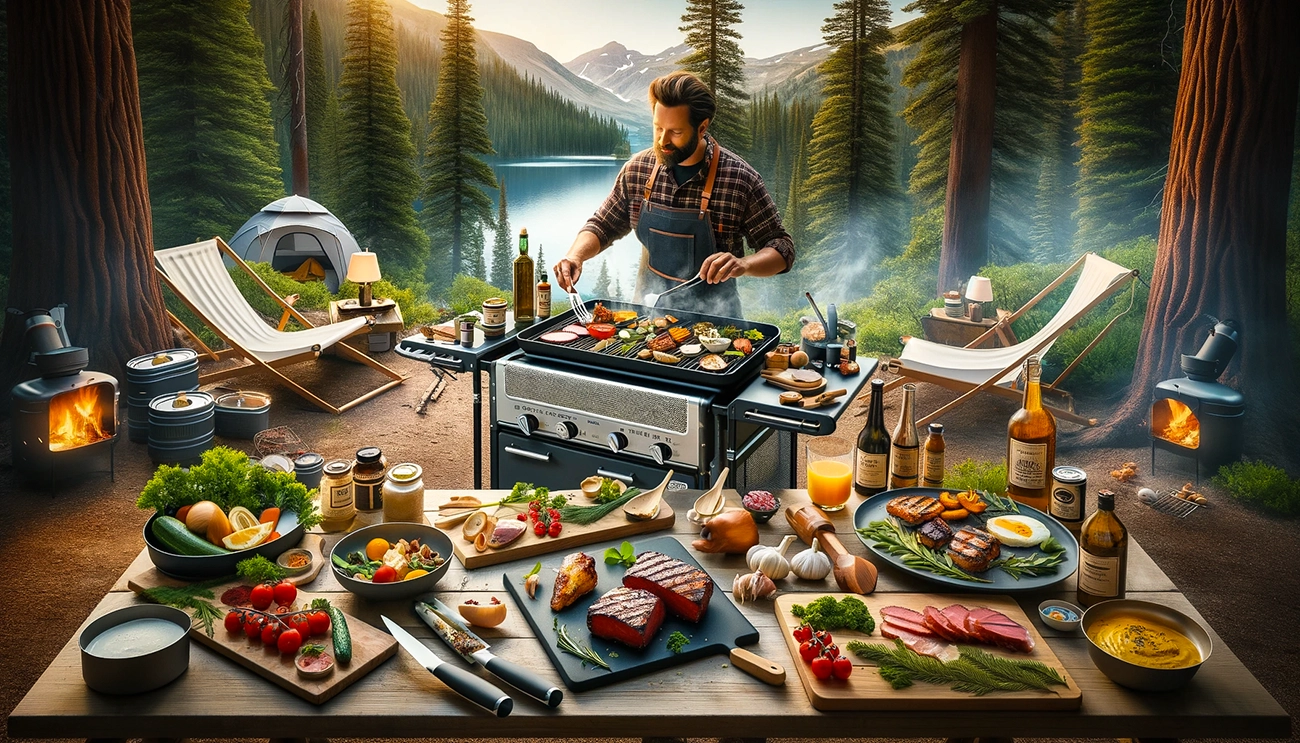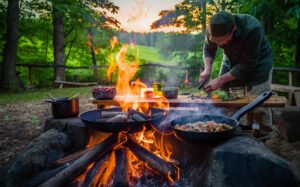Imagine the thrill of being out in nature, surrounded by the beauty of the great outdoors. Imagine being able to enjoy a delicious, gourmet meal while you’re camping. Yes, it’s possible! In this article, we’ll share some expert tips on how to cook gourmet meals on a camping grill. Whether you’re a seasoned camper or new to the world of glamping, these essential pieces of information will ensure you can enjoy a truly unforgettable dining experience, even amid nature. Get ready to elevate your camping cuisine to a whole new level.
Choosing the Right Camping Grill
When choosing the right camping grill, a few essential factors must be considered. First and foremost, you’ll want to think about the size and weight of the grill. Since you’ll be carrying it on camping trips, you’ll want something lightweight and easy to transport. Look for a compact, lightweight grill that is still durable enough to withstand the rigors of outdoor cooking.
Another essential feature to look for in a camping grill is multiple cooking surfaces. This allows you to cook different types of food simultaneously, saving you valuable time and effort. Whether you prefer grilling burgers and hot dogs or want to try cooking seafood or vegetables, having multiple cooking surfaces will allow you to diversify your menu and cater to the preferences of your fellow campers.
Lastly, opt for a portable and durable camping grill. You want to ensure it can withstand the outdoor elements and is easy to clean. Look for a model made from sturdy materials with a secure locking mechanism to prevent spills and accidents during transportation.
Planning the Menu
Once you have chosen the perfect camping grill, it’s time to start planning your menu. The first step is deciding on the type of cuisine you want to serve. Consider your fellow campers’ preferences and dietary restrictions to ensure everyone can enjoy the meals. The choice is yours if you wish to go for classic backyard barbecue fare or experiment with international flavors.
Next, think about the number of people you will be cooking for. This will help you determine the quantity of ingredients you will need to bring. Remember that camping meals are generally more casual, so it’s a good idea to plan for group-friendly dishes that can be shared.
Plan meals that require minimal prep to make your camping cooking experience as easy as possible. Consider dishes that can be prepared in advance or require minimal cooking time. This will allow you to enjoy the great outdoors more and less time slaving over a hot grill.
Preparing Ingredients in Advance
To streamline your camping cooking process, it’s a good idea to pre-cut vegetables and store them in ziplock bags. This will save you time and effort at the campsite, allowing you to focus on the actual cooking. Additionally, marinating meats and seafood the night before not only helps to enhance the flavors but also saves you valuable time when you’re out in the wild.
If you have the time and resources, pre-cooking certain ingredients at home can also be a great way to simplify your camping cooking experience. For example, you can cook pasta or rice beforehand and store them in airtight containers. This way, all you have to do at the campsite is heat them and pair them with your grilled meats and vegetables.
Packing Essential Cooking Tools
When it comes to packing essential cooking tools for your camping trip, a few items should not be overlooked. First and foremost, bring a good set of knives and a cutting board. These will come in handy when prepping your ingredients and can make all the difference in the ease and efficiency of your campsite cooking experience.
In addition to knives and a cutting board, it’s essential to carry a selection of cooking utensils. Think about how to flip burgers, stir sauces, and handle hot pots and pans. A spatula, tongs, and a large spoon are all must-haves for any camping cooking adventure.
Lastly, don’t forget to pack measuring cups and spoons. While camping cooking can be more flexible and forgiving in terms of precise measurements, having these tools on hand can help ensure that your recipes turn out just right and that you can recreate your camping cooking successes at home.
Building and Starting the Fire
Before you can start grilling, you’ll need to build and start a fire. Choosing a suitable location for your grill is essential to ensure safety and efficiency. Look for a flat, stable surface away from overhanging branches or flammable materials. It’s also important to check local regulations and restrictions regarding open fires before you begin.
When it comes to gathering firewood or charcoal, make sure it is dry and ready to burn. Wet or damp wood can be difficult to ignite, creating excessive smoke. If you’re using charcoal, opt for high-quality briquettes that provide even and consistent heat.
To ignite the fire, you can use fire starters or kindling. These can be easily purchased at camping supply stores or made using newspaper, dry twigs, and matches. Place the fire starters or kindling at the base of the fire pit or grill and carefully light them. Gradually add more fuel as the fire grows, ensuring proper ventilation to maintain a steady and even burn.
Setting Up the Grill
Once your fire is burning, it’s time to set up the grill. Before you begin cooking, cleaning and oiling the grill grates is essential. This will prevent food from sticking and make cleanup easier. Use a grill brush or scraper to remove any leftover residue from previous uses, and then apply a thin layer of oil using a brush or paper towel.
Next, assemble the grill according to the manufacturer’s instructions. This may involve attaching legs, side tables, or other components. Ensure all parts are securely fastened to avoid accidents or mishaps while cooking.
Ensuring proper ventilation is crucial to maintain a steady fire. Double-check that the vents on the grill are open and unobstructed. This will allow for efficient airflow and help regulate the temperature while you cook.
Cooking Techniques
When it comes to cooking on a camping grill, you can employ a few different techniques depending on the type of food you’re preparing. Direct grilling is ideal for fast-cooking items like burgers, hot dogs, and vegetables. Place the food directly over the flames or hot coals and cook until done, flipping as needed.
Indirect grilling is the way to go for slower, more thorough cooking. This involves creating two heat zones on the grill: direct heat and indirect heat. Place the food on the side of the grill with indirect heat and close the lid, allowing the food to cook slowly and evenly.
Another useful technique for camping cooking is using foil packets. These are great for easy and mess-free meals. Wrap your ingredients in aluminum foil, seal them tight, and place them on the grill. This method is perfect for cooking delicate fish and creating flavorful vegetable medleys.
Recipe Ideas and Tips
Now that you have the basics down, it’s time to get creative with your camping cooking! Here are a few recipe ideas and tips to inspire you:
- Grilled shrimp skewers with lemon and herbs: Marinate shrimp in a mixture of lemon juice, olive oil, garlic, and your favorite spices. Skewer the shrimp and grill until cooked through and slightly charred. Serve with a squeeze of fresh lemon juice for a refreshing and flavorful dish.
- Vegetarian kebabs with marinated tofu and vegetables: Cut tofu and your favorite vegetables into bite-sized pieces. Marinate the tofu in soy sauce, ginger, garlic, and sesame oil. Thread the tofu and vegetables onto skewers and grill until lightly charred and tender. Serve with a side of rice or quinoa for a satisfying vegetarian meal.
- Grilled peaches with a honey-balsamic glaze: Cut peaches in half and remove the pits. Brush the cut side with a mixture of honey and balsamic vinegar. Grill the peaches, cut side down, until caramelized and slightly soft. Serve with a dollop of whipped cream or a scoop of vanilla ice cream for a simple yet delightful dessert.
Remember, camping cooking is all about improvisation and having fun. Don’t be afraid to experiment with different flavors and ingredients to create your camping culinary masterpieces.
Food Safety and Hygiene
While enjoying the great outdoors, it’s important to prioritize food safety and hygiene to prevent any illnesses or mishaps. Clean and sanitize your hands and cooking surfaces regularly, especially after handling raw meats and seafood. Use hot, soapy water or sanitizing wipes to ensure cleanliness.
Keep raw and cooked foods separate throughout the cooking process to prevent cross-contamination. Use separate cutting boards and utensils, and avoid using the same plate or platter for raw and cooked foods unless thoroughly washed.
Ensuring that meats and seafood are cooked to the proper temperature is crucial for food safety. Use a food thermometer to check the internal temperature, ensuring it reaches the recommended temperature to kill harmful bacteria. It’s also important to allow meats and seafood to rest for a few minutes before serving to allow the juices to redistribute.
Cleaning and Maintenance of the Grill
After enjoying a delicious meal, it’s time to clean and maintain your camping grill. Scrape and clean the grates after each use to remove leftover food particles and prevent them from sticking during your next grilling session. Use a grill brush or scraper to remove residue effectively.
Properly dispose of ashes or charcoal residue. Allow the fire to completely extinguish and cool before handling any remaining coals or ashes. Once cool, place them in a designated area or bag and dispose of them according to local regulations.
To prevent rust and ensure the longevity of your camping grill, apply a protective coating after cleaning. This can be as simple as a light layer of cooking oil or a specific grill protector spray. This will help keep your camping grill in top shape for many more outdoor adventures.
By following these tips and techniques, you can become a camping grill master. With the right grill, menu planning, preparation, cooking techniques, and proper maintenance, you can cook gourmet meals on a camping grill that will impress your fellow campers and leave them wanting more. So, pack up your gear, choose your destination, and get ready to embark on a culinary adventure in the great outdoors. Happy camping and happy grilling!



